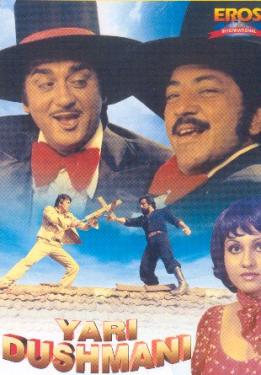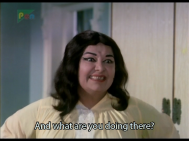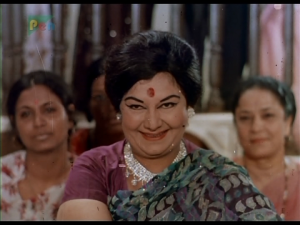Or:
Should you buy a DVD just because Sunil Dutt is wearing a hat on the cover?
 Yari Dushmani is a crazy masala bromance starring Sunil Dutt, Amjad Khan and Reena Roy among others. Directed at a cracking pace by Sikander Khanna, with an incident packed screenplay and zingy dialogue (Aziz Qaisi) and music by Laxmikant Pyarelal, it’s not really a film to analyse but there was loads to enjoy.
Yari Dushmani is a crazy masala bromance starring Sunil Dutt, Amjad Khan and Reena Roy among others. Directed at a cracking pace by Sikander Khanna, with an incident packed screenplay and zingy dialogue (Aziz Qaisi) and music by Laxmikant Pyarelal, it’s not really a film to analyse but there was loads to enjoy.
Apologies/warning: It’s Easter Sunday and I’ve been surrounded by a gaggle of toddlers under the influence of chocolate for the last few hours, so I’ll be taking the easy way out and relying heavily on pictures for this post.
I happened to start watching this at the same time that Beth was watching another Sunil Dutt film. The films were different but the reason for buying the DVDs was the same – the cover featured Sunil Dutt in a striking hat. I’ve bought a number of DVDs on the strength of the cover and have been bitterly disappointed to find that there were no giant parrots or women dressed as Cleopatra in the film. Naturally we were each curious to see if the movie lived up to the promise of headgear, and if the hats enhanced the film in any way. Oh, and was the film any good. Are hats a reliable indicator of entertainment in a film?
The story opens with two feisty and foul mouthed urchins (one is Master Bittoo but I’m not sure who the other kid is) living on the streets. They are resourceful, try to help people in need and they have a creative approach to finding paid opportunities.
They grow up into Shankar (Sunil Dutt) and Birju (Amjad Khan). Thugs, thieves, crims call them what you will. They have a significant cigarette lighter and a jaunty song (Hai Hum Galiyon Ke if you’re interested) which includes a fight, the hats on the DVD cover, and a flashback to their orphan days.
Pammi (Reena Roy) is also on the shady side of the law. She uses her charms to entrap men, and then threatens to cry rape unless they pay up. Her virtue is intact and she is a good bad girl, which is spelled out in the dialogue with her would be pimp Jumbo (Jankidas). She fleeces Shankar and Birju, but Shankar still comes to her aid when Jumbo threatens to sell her.
In an effort to make amends and help herself out of a tricky situation, she tells the chaps of a plan to rob a wealthy wedding and suggests they knock the place over first. This is a good idea as it includes Amjad Khan in bandleader get-up, and a qawwali featuring Reena Roy and Sunil Dutt (and more hats).
But Birju is in love with Komal (Daljit Kaur), a nightclub chanteuse. She sings about love, but only loves money. He cannot resist keeping the haul of diamonds to himself and he uses the loot to buy the discotheque Komal performs in, effectively buying her.
He gets a fancy house, flashy clothes, and a taste for the high life. His love for Komal seems to be tied to how much she is worth, and he expects her to entertain businessmen so he can win more contracts. His early Robin Hood ethic is nowhere in sight.
Shankar has no idea his friend betrayed him. He languishes in jail following the million dollar diamond heist, and obviously people are keen to know where he hid the gems. Doing time with him are murderer Peter Perera (Roopesh Kumar), thug Bhim Singh (Dev Kumar) and a little person. Bhim Singh is the brother of a notorious daku Darjan Singh (Shakti Kapoor). Peter killed his brother-in-law over 100 million dollars worth of diamonds.
Roopesh Kumar could not be accused of underplaying his flashback confession.
Shankar intervenes when Peter is beaten up. Now, I like to think I am not easily shocked or surprised but of all the things I fearfully anticipated happening when Shankar slung the dwarf over his shoulder, this was not one.
So added to the betrayal of friendship and the original theft, we now have a bigger stash of gems, a repentant murderer, a crazy and unrepentant daku, and a young mute boy who is the only living person who knows where the diamonds were hidden.
Shankar is released from jail, and thanks to Pammi he knows Birju has sold him out. Reena Roy gets some really entertaining scenes as Pammi outwits men who want to buy her, and uses the police to get rid of Jumbo. She is a smart girl in the midst of utter madness, and pretty handy in a fight. Reena Roy plays it to the hilt and I really enjoyed her presence in the film. Pammi moves into Birju’s house as his old friend. He suspects nothing, but she is working to protect Shankar from treachery. I will just digress again – what’s with the footprint motif on the bedhead?
Anyway. Birju makes several ill conceived attempts to kill Shankar as he cannot contemplate sharing his wealth.
He even sends a gang of Lego men (more headgear!) to beat up his old dost.
The two men journey into the hills, and things come to a head. Shankar leaves Birju with his neck in a noose and his feet precariously balanced on a handy wagon wheel. They go their separate ways. Or do they? Despite the silliness of the plot, they are both very good in their roles. I don’t think I’ve struck a Sunil Dutt film yet that hasn’t at least been interesting. And Amjad Khan gets to be more than a one dimensional baddie.
Everything and everyone converges on Girijapur, Peter Perera’s home, and the location of the priest (Bharat Bushan) who received his last confession. As with all secrets, everyone knows that the priest knows, and various parties set out to make him talk.
Shakti Kapoor and his gang raid the village in search of loot, interrupting a comedy wedding (Tun Tun and Rajendranath), and shoots the priest. And here is where I learned something never mentioned in my 12 years in a convent school.
So that’s how priests are made. My Jesuit friend will be gutted he wasted so many years studying. Whether for spiritual or other reasons, Sunil Dutt starts wearing a pith helmet.
Amjad Khan meanwhile decides to move into the village and impersonate the police, perhaps for the hat or maybe for the roomy uniform.
Reena Roy develops sharp shooting skills and has a nice line in 70s frocks and the occasional cap. She and Shankar are in love but I am not sure how that works with his being a priest and all. She is as active in defence of the village as he is, and she is also the caretaker for Komal who has turned up, pregnant and rejected by Birju. Pammi usually has a gun in her hand and the villagers accept her orders. And they develop some excellent defences including bombs and disguising themselves as haystacks.
Sunil gets to, well, joust in one fight with Shakti so I guess they felt the pressure to be really really macho.
The climax of the film involves gunfire, explosions, young Munna the no longer mute being tossed around like a rag doll, lots of punch ups and a moral dilemma. Will Birju finally value friendship over sparkly stones? Or will he take the money and run?
You’ll have to watch it to find out. But one thing I will share is a foolproof method for despatching Shakti Kapoor – the pointy end of a crucifix.
Happy Easter!
Oh I suppose I should make this a happy post. Here is how things look at the end:
And a little bit of advice next time you shop for DVDs.























































